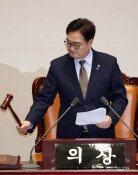A country whose 51% of population lives in capital and nearby region
A country whose 51% of population lives in capital and nearby region
Posted November. 02, 2023 08:52,
Updated November. 02, 2023 08:52
The People Power Party has decided to propose a special law to include Gimpo in Gyeonggi Province as part of Seoul this week. Such a decision is questionable as it was made hastily without consideration for how to develop Seoul from the perspective of ‘megacity’ competition with other advanced countries and ensuring balanced development across the country.
Advanced countries are strengthening their competitiveness in both industries and housing by improving the transportation system that integrates large cities and nearby regions to ensure fast and convenient movement. The U.K. has been developing Greater London since 1963 and expanded the boundaries of London to the mouth of the River Thames when it hosted the 2012 London Olympics. France has been pursuing the Grand Paris project since 2007 to expand Paris to Le Havre, a port city, as Paris is so small and disconnected from the suburbs that racial tensions increase. The U.S. also began implementing the ‘mega city’ development strategy by dividing the country into 100 areas, stepping away from its previous plan focused on small cities in the countryside.
If Seoul is to join such a megacity competition, the first issue to be addressed is how to connect Seoul and the Gyeonggi region including Incheon where an international airport and port. Simply including Gimpo and other residential cities through administrative adjustments does not make the capital a competitive megacity. It may increase the inflow of people and materials into Seoul, simply worsening the existing congestion in Seoul.
While the population in Seoul reportedly began to decrease, 9.4 million people still reside in the city. Seoul and its nearby region only account for 11 percent of the country by area, but 51 percent of its population lives there. A series of serious problems – the excess and shortage of labor, surging housing prices, and declining fertility rate – are caused by the excessive concentration in the region. The top priority is to disperse industries and population concentrated in the region by developing rural areas, rather than expanding Seoul.
A special union for Busan-Ulsan-South Gyeongsang Mega City was launched early this year but fell through. The previous method of establishing special zones for the economy or education is not sufficient for the actual development of the rural region. Japan is producing positive outcomes through the integrated efforts of local governments, including Osaka and Kyoto, not its capital and nearby regions. South Korea should come up with plans to develop mega cities in the rural region along with those to reinforce Seoul’s competitiveness.







